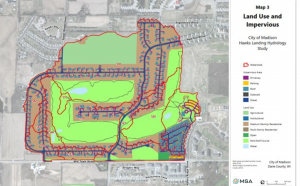MSA was hired by the City of Madison to complete a flood study in order to determine the cause of recurrent flooding within a relatively recently constructed residential subdivision on the City’s far-west side. This neighborhood was less than 20-years old at the time MSA was hired, and while the tools available for the original development were not as sophisticated as those available today, they certainly had the ability to prevent the spectacular flooding that this neighborhood experiences — but regrettably, did not.

Images taken by residents during flooding events the neighborhood experienced during the course of this project.
Before we could evaluate potential solutions to the flooding problem, MSA needed to thoroughly investigate the potential causes. Our investigation began with a forensic review of the original designer’s calculations for the stormwater management system. Given the frequency and severity of the flooding being experienced, we were surprised to find that the original site designer had, indeed, completed their work to the standard of care expected at the time.

GIS map showing land and impervious areas within the 305-acre study area.
However, as we dug deeper, we discovered some significant items beyond the control of the designer that contribute substantially to the flooding problem. Of greatest significance was the publication of a new hydrologic atlas which increased the estimated 100-year rainfall depth from 6.00 inches to 6.66 inches. Coming in at a close second was a near wholesale reclassification of soils within the watershed from HSG B to HSG C, which resulted in a substantially higher runoff coefficient for the watershed. Of lesser importance, but still notable, were inconsistencies between how proposed detention ponds were constructed relative to how they were designed, and the addition of approximately 30 acres of watershed area due to storm sewer extension projects. Collectively, these issues caused a 45% increase in estimated runoff rates and a 35% reduction in intended flood storage. The drainage and stormwater management system were undersized.

GIS map showing peak depths anticipated to occur in one part of the watershed under 100-year flood conditions. Each color gradation represents an increment of 6″ of flood depth, with red areas indicating over 2.5′ of flooding.
In order to understand the magnitude of the effects of these changes in runoff conditions, MSA prepared a 2D SWMM model of the 354-acre drainage area tributary to the problem area. The model was constructed by combining data from the following sources: construction plans for three developments within the watershed, aerial photos and contour mapping, infrastructure mapping provided by the City, extensive topographic survey collected by MSA surveyors, and visual observations taken by MSA engineers.

Plans for a new detention pond constructed in 2018 and an image of the pond after construction.
MSA worked with City of Madison staff to identify three principal improvements that will provide 100-year flood protection to the existing residences. These improvements consist of four separate phases and include a combination of increased flood storage in the upper portions of the watershed and increased drainage capacity in the lower portion of the watershed. System improvements have been completed in multiple phases since 2018 and are achieving the goal of providing 100-year flood protection to residences within the development and surrounding area.
